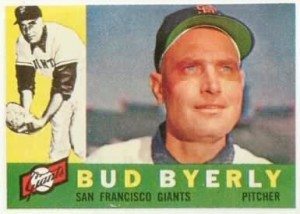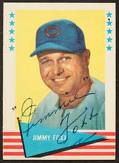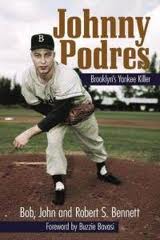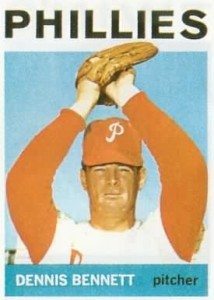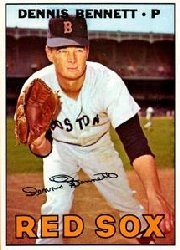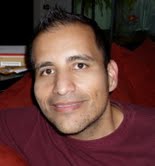 |
| Meet Juan Rosales, the spirit behind Baseball Interactions! |
Finding someone else who cheers for your favorite team is a good feeling. Finding someone who shares your perspective on a hobby is simply amazing.
The first time I spotted the blog Baseball Interactions, I had to know more. This wasn’t someone else saying they wanted to get every autograph in existence, any way possible. Someone else valued quality over quantity.
This someone is Juan Rosales. His story is as intriguing as the tales he’s uncovered from former players each day. Juan was kind enough to answer tons of questions for Baseball By The Letters readers.
Q: Juan, when and what was the first baseball note, the hand-written memory in addition to an autograph, that you received? Was it asked for, or was it an extra surprise?
A: I began collecting autographs through the mail in late 1989. At the time, I was 11 years old and had just really started getting into baseball several months before. I had accumulated a lot of baseball cards by that point, and, living in the Dallas area at the time, I had met a few Rangers in person and got them to sign some of the cards for me. I thought it would be fun to add to my collection by writing to players in addition to getting in-person signatures.
At the time, though, I was more interested in the QUANTITY of autographs over anything else. I didn’t think about asking questions in my letters; I just wanted to fill my binders with autographed cards. By that point, I was already way more knowledgeable about baseball than my friends were, and I wanted to have a great quantity of autographs as a sort of ‘bragging right’ thing. I loved it, but all I cared about were the autographs and not necessarily the interactions.
By virtue of my collecting goals, I received many signed cards but little else. One day in 1991, however, I received a response from former pitcher Jim “Mudcat” Grant. Not only did he sign the cards I sent him, but he also enclosed a nice note as well, basically wishing me luck with my collection and advising me to stay away from drugs. This was the first real hand-written memory I received from a player and it was completely unexpected. It was a great surprise. I still have the note somewhere; I need to look for it so I can post it on my blog.
Q: What were your original goals as a by-mail autograph collector? Did you start with current players?
A: Like I said, I wanted to get as many of my cards signed as possible. I began by sending to some of the players who were active at the time, and within several months I found myself writing to Hall of Famers and many other retired players. By the time I was 13, I had acquired around 30 Hall of Fame autographs via mail and maybe an additional 150-200 signatures from retired players who had played between 1930 and 1960. I found it a lot more fun to write to the old timers.
Q: What are the best sources for addresses of retired players for you?
A: When I first started, I used Jack Smalling’s address list. The last edition I bought was the 1992 edition. I kept that book for several more years, and I found that most of the addresses hadn’t changed. Sometimes I would get my mail returned (RTS) but for the most part, it was reliable. Once I relocated for college (1996), I was introduced to the internet, and I found many current and updated addresses online. Since then, I’ve been using the internet as my primary source. I’m aware of Harvey Meiselman’s address lists, but I haven’t purchased his product, simply because I’m able to find valid addresses online with a little research.
Q: Can you share a story of researching an address on your own, finding a “lost” retired player?
A: I guess the closest I can think of is whenever I’ve received an RTS response with the player’s new address printed on the yellow label. I’ve never really been one to conduct in-depth research to find a specific player’s address. If I’m unable to find a mailing address for a player, I’ll move on to another player and hope that a valid address will pop up soon.
Q: What kind of research do you do on a person before writing?
A: For the more well-known players, I’m usually already somewhat familiar with their careers, so I won’t have to research them very much. Sometimes I’ll come across a through-the-mail experience that someone had with a player that was positive, and it’ll prompt me to write to that player. If I’m not already familiar with him, I’ll look up the basic stuff- lifetime stats, teams he played on, career accomplishments, etc. I always customize my letters specifically to the player I’m writing to and I always include items about his career that have stood out to me.
Q: What kinds of questions have brought the best responses? Are you only asking questions, or do you ask for an autograph, too?
A: I’ll ask for an autograph as well. I’ll include a custom-made index card – something simple that shows them that I’m interested in their autograph but don’t plan on selling it. As for the questions, I don’t like to ask the same generic types of questions that many other people ask- questions like, “Who was your favorite pitcher to hit off of?” or “What did you like most about playing in the Major Leagues?” I’ll go more in-depth than that. When I first started asking questions back in ’96 or ’97, I used the technique of asking generic questions but, looking back, I really wish I had taken more time to ask something more creative.
As for the questions that have brought the best responses: it’s typically the questions that show that I’ve done some research on the player’s career or post-career life. Probably the best response I’ve received was when I wrote to former pitcher Bob Meyer around 10 years ago. I put this interaction up on my blog. Mr. Meyer wasn’t a household name in MLB but he went on to become a successful businessman after his playing days were over. I asked 3 questions- including one regarding his business career- and he sent back a long and in-depth response. He seemed appreciative that I did my research on his career and that I was genuinely interested in interacting with him. To summarize, I try to ask specific questions related to a certain aspect of a player’s career or life that show that I’m an actual fan and not just another autograph collector. The players seem more appreciative of this.
Q: How would you answer a collector who says, “What if your question is hard? That might make someone who’d sign an autograph not answer at all!”
A: I would tell the collector that I’ll always use my best judgment. If I find out that a player enjoys interacting with fans and talking about his career, then basically anything goes regarding my willingness to ask a certain question regarding his career. I might ask him to recount a certain event, or to give his opinions on playing for a certain coach, or to talk about a specific home run he hit. When I wrote to former Red Lonny Frey, for instance, I asked for his thoughts on his manager Bill McKechnie, and I also asked him to compare the pitching staff of the 1930s-1940s Reds to that of the 1990s Braves. I got back a great response. I asked these questions because I knew he enjoyed interacting with fans and was very insightful and generous with his time.
Sometimes, though…and as much as I like to stay away from these kinds of questions…the more simple, more generic ones work best if I know that a player won’t be as likely to respond based on habits of theirs that I’ve read about.
Q: What’s been the best part of sharing your responses in a blog?
A: Much like you, I like writing out of personal enjoyment. I had been interacting with players for so long and receiving written responses, and for the longest time, my responses were just sitting in a box. I wanted to come up with a way to display them. The idea of writing a blog never interested me, but in early 2011 I started looking around on the internet at all the other people who had blogs and the different things they would write about. It finally occurred to me that having a blog would be a good (and easy) way to share my interactions with fellow collectors.
Q: Asking questions is a quality-versus-quantity question for me. I’d rather have one insightful comment from a retired player, than five cards he autographed in seconds. How would you answer someone who says you’re getting only one letter, when they’re filling binders with several cards per reply?
A: Basically the same way you would. Whereas I might have been interested in getting 20 cards of a certain player autographed when I first started writing to players, I’m now much more interested in the interactions themselves. It’s interesting to see how much you can get a player to open up if given the chance.
Q: I feel that a former player needs to know a bit of who I am in the letter. This tells why I want, or deserve, a response. How much of yourself do you add in a letter, such as telling about how long you’ve been a fan, attending a game or watching a certain play on TV?
A: I’ll let them know my age, and how long I’ve been a fan of MLB. Also, I’m honest with them up front regarding their career. If it’s a player I followed when I was younger, I’ll let him know that I’ve been a fan since (insert year). If it’s an older player whose career I’m familiar with, I”ll tell him HOW I became familiar with his career and include tidbits of interest that have jumped out at me. If it’s a player I previously had no knowledge of, I’ll tell him something along the lines of, “…upon researching your career, I find it interesting that (insert career fact)…” I always want to make sure he knows that I’m familiar with him at least to some degree. I can’t tell you how many times I”ve seen someone send the same form letter (sometimes photocopied) to a group of players that comes off insincere and generic. I mean…it does no good for a 15-year-old collector to tell a player from the 1950s, “…you’re one of my favorite baseball players…you’ve contributed so much to the game…can I have your autograph?” if they can’t specify something specific about his career. People should put at least some thought into their letters and mention specific things.
Q: Goals for your blog?
A: I just want to keep writing to more players, keep having fun writing my entries, and try to get more people to follow me and read my entries. I’m having a lot of fun doing it and I’ve learned a lot about maintaining a blog.
Q: Advice to collectors or fans wanting to send letters for baseball research?
A: Don’t write to players just because other people have done it and it looks like it would be something cool to do. Write to players because it’s something that you genuinely enjoy doing. I’m a huge baseball fan and I love getting feedback from players because, more than anything, I’m a fan of the HISTORY of the game. I like to keep up with current MLB players, but I get a huge thrill out of writing to players from the past and hearing them talk about how certain aspects of their careers. Don’t get me wrong- I love to communicate with current players too- but I think the point I”m trying to get across is that if you have an actual interest in communicating with players, regardless of the era in which they played, this will be a much more rewarding hobby, as opposed to writing to them for the sake of writing to them.
Thank you, Juan, for a great hobby “interaction.” This is a blog worth following!
Coming Monday: Grateful outfielder Johnny Grubb

